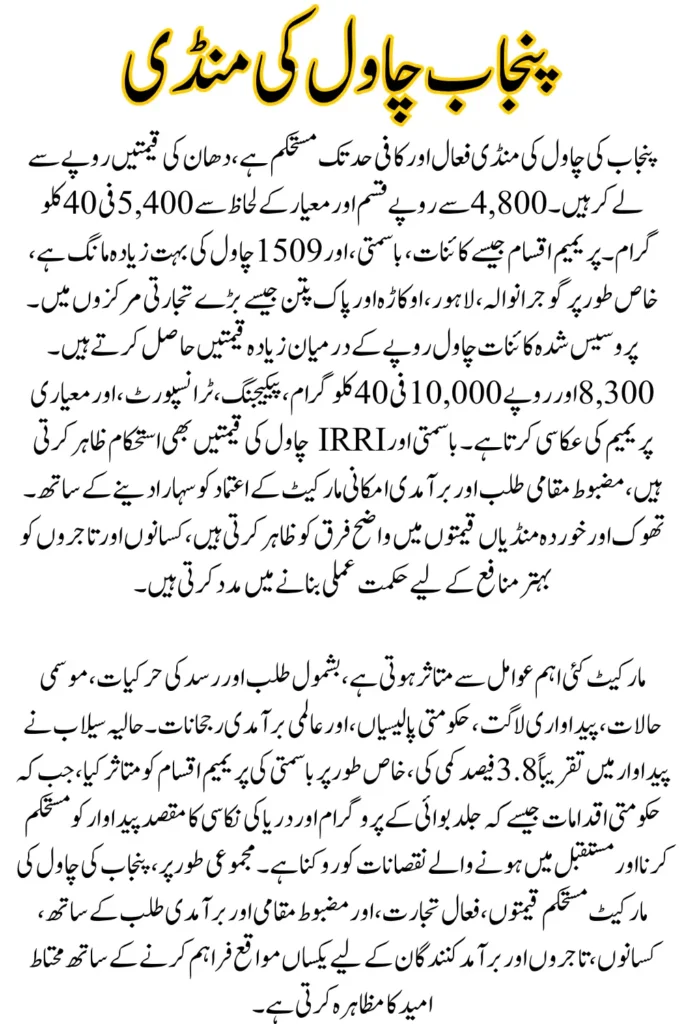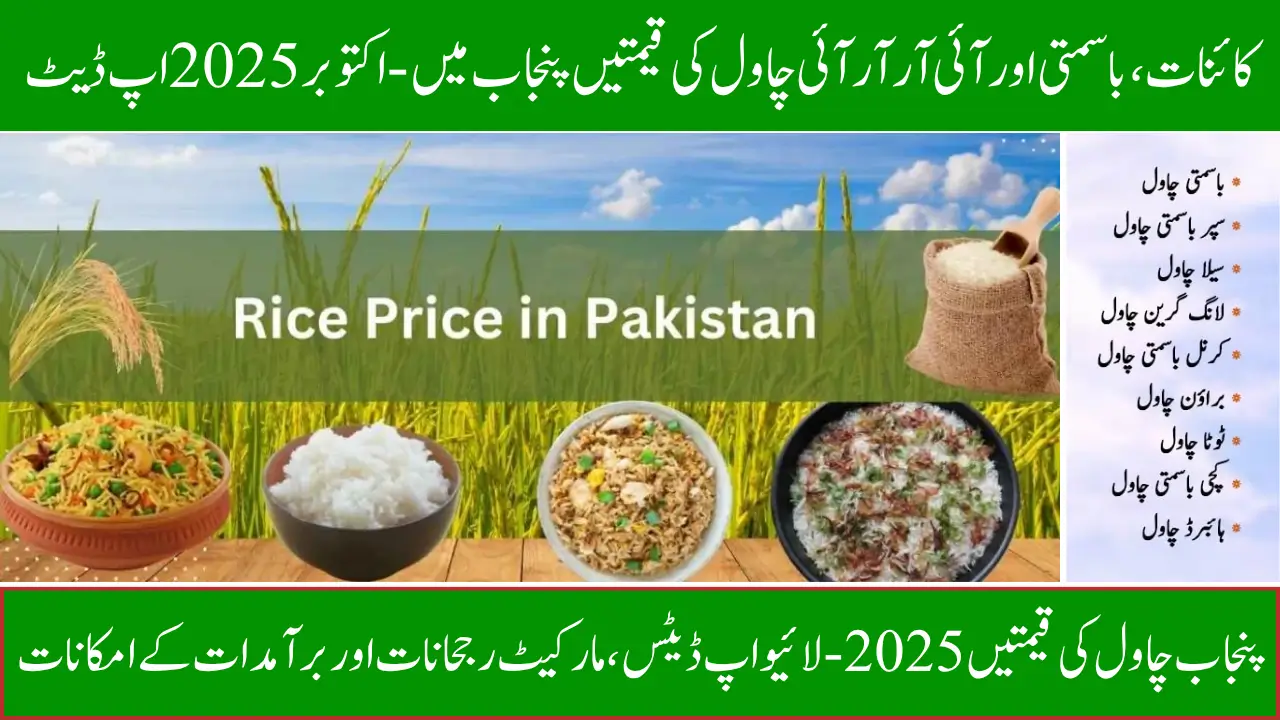Punjab Rice Prices Today in Pakistan, Latest Market Updates
Rice prices in Punjab remain stable, with slight variation between cities. The current paddy rate ranges from Rs. 4,800 to Rs. 5,400 per 40 kg, depending on the rice type and quality. Popular varieties like Kainat, Basmati, Super, and 1509 rice are in high demand. In cities such as Arifwala, Okara, Pak Pattan, and Vehari, Kainat paddy sells between Rs. 5,200 and Rs. 5,400 per 40 kg, showing strong market activity and farmer confidence.

Processed Kainat rice is priced higher, starting from Rs. 8,300 to Rs. 10,000 per 40 kg across Punjab. Factors like supply, weather, and demand influence daily price changes. Punjab’s fertile plains, especially Gujranwala, Sahiwal, and Bahawalnagar, produce top-quality rice for both local and export markets. Farmers and traders can expect stable prices if weather and export trends stay favorable in the coming weeks.
City-Wise Rice Rates Across Punjab Live Market Data
| City | Kainat Paddy (40 Kg) | 1509 Paddy (40 Kg) | Kainat Rice (Processed, 40 Kg) | Market Trend |
| Arifwala | Rs. 5,200 – 5,400 | Rs. 4,920 – 5,150 | Rs. 8,500 – 9,900 | Stable to High |
| Burewala | Rs. 5,150 – 5,320 | Rs. 5,000 – 5,100 | Rs. 8,400 – 9,800 | Increasing |
| Bahawalnagar | Rs. 5,100 – 5,300 | Rs. 4,800 – 5,000 | Rs. 8,300 – 9,700 | Stable |
| Chishtian | Rs. 5,000 – 5,290 | Rs. 4,600 – 4,890 | Rs. 8,550 – 9,900 | Rising Demand |
| Hasilpur | Rs. 5,050 – 5,250 | — | Rs. 8,350 – 9,800 | Steady |
| Haroonabad | Rs. 5,100 – 5,350 | — | Rs. 8,300 – 9,800 | Firm |
| Mian Channu | Rs. 5,100 – 5,300 | Rs. 4,550 – 4,950 | — | Stable |
| Okara | Rs. 5,100 – 5,350 | Rs. 4,700 – 4,950 | Rs. 8,700 – 10,000 | High |
| Pak Pattan | Rs. 5,200 – 5,380 | Rs. 4,800 – 5,150 | — | Positive |
| Rahim Yar Khan | Rs. 5,110 – 5,300 | — | — | Stable |
| Sahiwal | Rs. 5,000 – 5,280 | Rs. 4,550 – 4,900 | Rs. 8,300 – 9,800 | Active |
| Vehari | Rs. 5,200 – 5,400 | — | — | Increasing |
| Lahore | — | — | Rs. 8,600 – 10,000 | High Retail |
| Faisalabad | — | — | Rs. 8,500 – 9,900 | Moderate |
| Multan | — | — | Rs. 8,500 – 9,900 | Consistent |
| Sargodha | — | — | Rs. 8,400 – 9,800 | Steady |
Quick Insights:
- Kainat and 1509 are Punjab’s top rice varieties with high local and export demand.
- The highest prices are recorded in Okara, Lahore, and Pak Pattan.
- Market trend across Punjab is stable with a slight upward movement
Punjab rice prices remain stable today, with Kainat and 1509 varieties ranging between Rs. 4,800 and Rs. 5,400 per 40 kg, showing steady market demand.
Basmati and IRRI Rice Prices in Major Punjab Cities
Basmati and IRRI rice prices in Punjab remain stable, with strong demand in key markets. Prices vary by city and quality, reflecting regional supply and trade activity. Farmers and traders are benefiting from consistent rates and active buying.
- Basmati Rice Price: Rs. 4,800 – Rs. 5,500 per 40 kg
- IRRI Rice Price: Rs. 3,400 – Rs. 4,500 per 40 kg
- Top Markets: Gujranwala, Sialkot, Okara, and Sahiwal
- Market Trend: Stable with slight upward movement
- Quality Factor: Premium Basmati holds its value due to aroma and export demand
Punjab’s rice market stays firm with steady Basmati and IRRI prices and strong local demand.
Factors Affecting Today’s Rice Prices in Punjab
Rice prices in Punjab change daily due to many local and global factors. Farmers, traders, and consumers closely watch these changes to plan better. Stable weather, balanced supply, and low production costs help keep prices steady, while poor conditions can raise rates quickly.
- Supply and Demand: Low yield or high demand increases prices.
- Weather Conditions: Floods or droughts affect rice output.
- Production Costs: Higher seed, fuel, and fertilizer costs raise prices.
- Government Policies: Export rules and support prices impact the market.
- Rice Variety and Quality: Premium types like Basmati get higher rates.
Rice prices in Punjab depend mainly on supply, weather, costs, and government policies.
For More Information: Avoid BISP 8171 Disqualification in 2025, Easy Solutions to Stay Eligible
Comparison of Rice Rates Across Different Markets
Rice rates vary across Punjab due to market demand, crop quality, and transportation costs. Major trading cities like Gujranwala, Lahore, and Okara show slightly higher prices because of better grain quality and strong buyer demand. Smaller markets record lower prices, mainly due to local supply and less export activity.
- Gujranwala & Lahore: Rs. 8,600 – 10,000 per 40 kg (Premium Kainat & Basmati)
- Okara & Pak Pattan: Rs. 8,500 – 9,900 per 40 kg (Strong regional trade)
- Sahiwal & Bahawalnagar: Rs. 8,300 – 9,700 per 40 kg (Moderate rates)
- Vehari & Chishtian: Rs. 8,200 – 9,600 per 40 kg (Local market focus)
- Sindh (for comparison): IRRI-6 ranges from Rs. 2,300 – 2,600 per 40 kg (non-basmati variety)
Punjab’s major rice markets show stable to slightly higher rates, led by Gujranwala and Lahore due to high demand and export-quality produce.
For More Information: BISP 8171 New Digital Payment 2025, Easy CNIC Registration Tutorial
Wholesale vs Retail Rice Prices, What Farmers and Traders Should Know
Rice prices differ between wholesale and retail markets, affecting profits for farmers and traders. Wholesale rates are lower and reflect bulk trading, while retail prices include processing, transportation, and packaging costs. Understanding this difference helps sellers set better prices and buyers plan purchases efficiently.
- Wholesale Price: Rs. 4,800 – 5,400 per 40 kg (bulk paddy or processed rice)
- Retail Price: Rs. 8,300 – 10,000 per 40 kg (packaged and ready-to-sell rice)
- Key Insight: Retail margins cover processing, labor, and transport costs.
- Farmer Advantage: Selling at wholesale ensures quick turnover but lower profit per unit.
- Trader Strategy: Buying wholesale and selling retail maximizes margins if storage and quality are maintained.
Farmers and traders benefit by knowing wholesale is cheaper, retail earns higher margins, and timing sales smartly boosts profits.
For More Information: Punjab 11th Class Result 2025 Date and Time Announced, Check Full Details Here
Recent Trends in Punjab Rice Market 2025 Update
Punjab’s rice market in 2025 shows mixed trends. Floods and adverse weather have reduced production by about 3.8%, causing prices to rise. Premium varieties like Basmati are in high demand. Global market dynamics, including competition and export policies, are influencing trade. The government is taking steps to stabilize supply and prevent future losses.
- Production Decline: Floods reduced output by 3.8% this season.
- Price Increase: Limited supply and strong demand pushed prices higher.
- Export Challenges: Global competition and India’s policies affect exports.
- Government Measures: River desilting and flood management aim to protect crops.
Punjab’s rice market faces production and export challenges, but government actions help stabilize prices.
For More Information: 12th Class Supplementary Exam Dates 2025, All Boards Covered
Expert Analysis: Future Outlook for Punjab’s Rice Prices
Punjab’s rice prices are expected to remain stable to slightly positive in 2025. Early sowing increased paddy arrivals, but recent floods affected yield and quality. Global demand and export policies will continue to influence pricing, while government initiatives aim to support farmers and maintain market balance.
- Climatic Challenges: Floods reduced Basmati yield and quality.
- Policy Interventions: Early sowing programs increased paddy arrivals.
- Market Dynamics: Global rice prices and export rules impact local rates.
- Export Outlook: Pakistan targets 5.5 million tons for 2025/26 exports.
Punjab’s rice market shows cautious optimism with stable prices supported by government measures and strong export demand.
For More Information: Sahiwal Electric Bus Route Map, Fares and Timings, Complete Guide 2025
Final Summary: Today’s Rice Market Overview in Punjab
Punjab’s rice market remains active and stable as of 15 October 2025. Paddy prices range between Rs. 4,800 and Rs. 5,400 per 40 kg, depending on variety and quality. Premium types like Kainat, Basmati, and 1509 rice see higher demand, especially in key cities such as Gujranwala, Lahore, and Okara. Wholesale and retail markets show a clear difference, with processed rice fetching higher rates due to packaging, transportation, and quality considerations.
The market faces challenges from climatic events, such as recent floods, and global factors like export competition and policy changes. Government initiatives, including early sowing programs and river desilting, aim to stabilize production and prevent future losses. Overall, Punjab’s rice market shows cautious optimism, with steady prices, active trading, and strong local and export demand.
For More Information: Punjab Schools Closure 2025, Check District-Wise List
Common Questions
What is the current price of 40 kg of Kainat and Basmati rice in Punjab?
Kainat rice ranges from Rs. 8,300 – 10,000 per 40 kg, while Basmati prices vary between Rs. 8,500 – 9,900 depending on the city and quality.
How do wholesale and retail rice prices differ in Punjab?
Wholesale prices are lower (Rs. 4,800 – 5,400 per 40 kg) for bulk sales, while retail prices are higher due to processing, packaging, and transportation costs.
Which cities in Punjab have the highest rice prices?
Gujranwala, Lahore, Okara, and Pak Pattan typically record higher rice rates due to better quality and strong local and export demand.
What factors affect rice prices in Punjab?
Prices are influenced by supply and demand, weather conditions, production costs, government policies, rice variety, and global market trends.
How can farmers maximize profits in the current rice market?
Farmers can increase profits by using quality seeds, following modern farming practices, timing sales wisely, and participating in cooperatives or collective bargaining.
For More Information: CM Punjab Ration Card 2025, Complete Eligibility and Application Details









